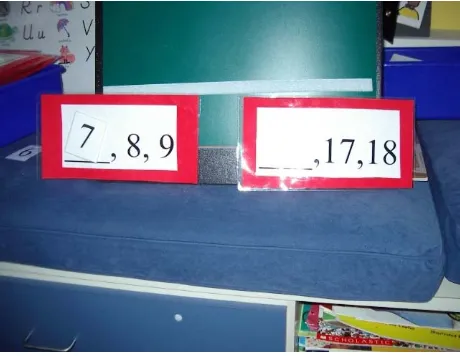Copyright © 2010 SciRes. DOI:10.4236/ce.2010.13023
Using an Exploratory Approach to Help Children with Autism
Learn Mathematics
Hui Fang Huang “Angie” Su
1, Leanne Lai
2, Herminia Janet Rivera
11
Nova Southeastern University, North Miami Beach, Florida, USA;
2
Nova Southeastern University, Davie, Florida, USA. Email: {shuifang, Leanne, hr176}@nova.edu
Received June 1st, 2010; revised September 23rd, 2010; accepted September 30th, 2010.
The exploratory study was carried out at a Choice school located in Davie, Florida. Thirty-four pre-school stu-dents with autism and their integrated, typically developing peers received 3 months of mathematics instruction during their regular school day. The purpose of the study was to identify the effective uses of instructional strat-egies that will impact students’ learning. Instruction consisted of both direct and embedded instruction derived from the Project MIND curriculum (Su, 2002). A comparing of the rates of acquisition of math skills for stu-dents with autism who received intervention with stustu-dents with autism who did not receive intervention revealed information about the specific learning abilities of students.
Keywords: Autism and Mathematics, Preschool Mathematics, Effective Mathematics Strategies for Children with Autism, Mathematics for Pre-School Age Children with Autism
Introduction (What is Autism?)
Autism is a complex neurological disorder which impairs one’s ability to socialize, communicate, process sensory infor- mation, and experience the full range of interests common to most people. In addition to the severe nature of the disorder, the prevalence of autism is increasing. The Centers for Disease Control (2007) reports that as many as 1 in every 150 persons has autism. The severity of the disability coupled with the in-creasing prevalence rate makes autism a priority among re- searchers whose focus is to uncover etiologies and effective treatments.
Early Intervention
While there is no known cure for autism, experts agree that the positive outcomes are highly associated with comprehend- sive, early intervention programs (National Research Council 2001). The importance of early intervention for young chil- dren with autism has been documented in the literature (Hurth, Shaw, Izeman, Whaley, & Rogers, 1999; National Research Council, 2001; Rogers, 1999). Rogers (1999) found that some types of early intervention appeared to reduce the debilitating impact of autism and those young children with autism may make gains more quickly than young children with other severe neurodevelopmental disorders. At present, early intervention programs differ markedly in terms of the specific strategies and interventions which are implemented. While the National Re-search Council broadly recommends early intervention, they also note that less is known about the efficacy of specific strat-egies for facilitating learning in children with autism. In partic-ular, little attention has been paid to developing programs and evaluating treatment as related to academic skills and the achievement of specific school readiness skills. While some research has been conducted in the area of reading, research on
strategies for teaching mathematics to students with autism is limited (National Research Council 2001). A good example is the study conducted by Stahmer, Collings, and Palinkas (2005) where they wanted to provide data on early interventions prac-tices in the classroom and they found special education teachers describing interventions related to speech therapy and occupa-tional therapy/sensory integration. The study provided an im-portant analysis of usage practices however; the authors rec-ommended future investigations to gain a broader understand-ing of methods and teachunderstand-ing strategies used in Early Childhood Education.
Mathematics
Teaching mathematics is an important and critical area for several reasons. For one, with the advent of federal legislation including No Child Left Behind Act (2001) there is an in-creased focus on including children with special needs in gen-eral education settings. All children are increasingly expected to participate in high stakes testing and their scores are included in school performance scores. Identification of effective ma-thematical instructional strategies for students with autism may facilitate success in both standardized testing and inclusion within the regular classroom setting.
Prepare Students in Life Skills
disabilities, including autism, is mathematics; functional math enhances an individual’s participation in daily routines and increases opportunities for jobs, volunteer activities, and leisure enjoyment later in life.
Because of the considerable evidence that many students with severe and multiple disabilities, including autism, have difficulty acquiring knowledge of mathematical concepts, it is important that educators use the most effective methods for teaching students mathematical skills. Butler (2001) found in their literature review of mathematics instruction that students benefited from interventions emphasizing frequent feedback, explicit instruction, and practice.
Strategies Used
Embedded instruction has also been suggested as one strategy that could be used with young children with disabilities in inclusive early childhood special education programs (Harrower, 1999; McDonnell, Johnson, Polychronis, & Riesen, 2002). In embedded instruction, students are taught skills within the ongoing routines of the classroom setting. Embedded instruction is similar to traditional teaching formats, the teacher implements instructional procedures designed to support the student's acquisition of the target skill. It differs in that the instruction is distributed across the activities that typically occur in the classroom setting rather than being presented one after another with short intertriai intervals. This is accomp- lished by presenting the instruction when teaching opportunities occur naturally during activities like music, movement, art, cooking, circle time, transition activities and outdoor play.
Objective of Study
The objective of this study is to evaluate the impact of sys- tematic instruction in mathematics on preschool children with autism. Specifically, this study will aim to answer the following questions:
• Does systematic instruction in mathematical concepts, uti-lizing direct and embedded instruction, lead to increased knowledge of mathematical concepts and the language of mathematical concepts in preschool-aged children with autism?
• What are the relative contributions of cognitive and visual spatial abilities on the ability to acquire knowledge of ma-thematical concepts?
• How does the rate of acquisition of mathematical concepts made by students with autism compare to the rate of progress made by same-aged, typically developing peers?
• What modifications to the Project MIND – Math Is Not Difficult® mathematics activities are useful when teaching mathematical concepts to students with autism?
Methodological Design/Data Analysis of
Participants
Four preschool classes serving students with high-function- ing autism (> 70 on measures of cognition) at the Pre-school were selected to participate. Two of the selected classes were those which exclusively served students with autism. The other two classes were integrated preschool classrooms which served
students with autism as well as typically developing peers. For the purpose of this study, one autism class and one inte- grated class were randomly assigned to a study group. The other two classes served as the control group. In all, 25 students with autism and 10 typically developing peers participated in the study.
Intervention
Pre-training: Prior to implementation of mathematics instruc- tion, all teachers received instruction and training on using The Project MIND approach (Su, 2002) a multi-sensory math cur-riculum, and on direct instruction of math. Classroom teachers participated in after-school training sessions from September through January and received frequent coaching visits and support by project staff to trouble shoot, provide resources, and to insure the curriculum was properly implemented.
Treatment: For students in the study group, systematic in- struction in mathematics using strategies based on The Project MIND approach was implemented for a period of 3 months. Systematic instruction was provided using both direct and em- bedded instructional strategies teaching mathematical concepts such as number sense, and numerical operations.
For direct instruction, students participated in 15-minute, teacher-led instruction sessions daily. Specific objectives taught were individually determined based on the results of pre-as- sessment data and student’s performance level in mathematics at the time of the study.
For embedded instruction, mathematical instruction was em- bedded into a variety of preschool activities including music, movement, art, cooking, circle time, transition activities and outdoor play utilizing strategies described in the Project MIND approach. The base 10 concept was taught through pairing up number “buddies” (Figure 1).
[image:2.595.308.538.515.693.2]The students were taught the base ten concepts utilizing a multi-game approach. Students used number tiles to match up numbers which add up to ten (Figure 2). This lays the founda- tion for algebraic thinking. The students were asked, “Who is 4’s best friend?” Then a number sentence was constructed (e.g. 4 + ____ = 10) or (_____+ 8 = 10).
Figure 1.
Concept building continued with a game called “Object Grab Game” (Su, 1988). Students were given three different methods to identify a number – objects, number cards, pictures cards (concrete, semi-concrete, abstract) (Figure 3) and (Figure 4). When prompted, students used any of the three ways to identify the number. For example, the teacher calls “7,” the student must quickly find its best Friend 3 using the objects, number cards, or picture cards. If the emphasis was on abstract thinking, then the student who used concrete objects to identify the best friends would receive the highest points.
Students were also given everyday objects to compare (Fig- ure 5) and (Figure 6). Here students identified the larger, small-er, shortsmall-er, and or longer of the two objects.
[image:3.595.308.539.83.256.2]One of the more difficult skills that the students were able to accomplish was to insert missing numbers when given a se-quence of numbers. For example, _____, 8, 9 (Figure 7) and (Figure 8).
Figure 2.
[image:3.595.56.293.281.460.2]Number tiles.
Figure 3.
Object grab game.
Figure 4.
[image:3.595.307.538.296.476.2]Student selects a strategy to respond.
Figure 5.
Longer or shorter.
Figure 6.
[image:3.595.305.538.512.693.2]Figure 7.
What number is missing?
Figure 8.
Students worked on double digits.
The Design
A quasi-experimental, pre- and post- with control group de- sign was used in the study (Shadish, Cook, & Campbell, 2002). In this design, both the study and control groups were given pre- and post-mathematics achievement tests using sub-tests from the Hawaii Early Learning Profile (HELP) (which as-sesses a student’s mathematical reasoning and problem solv- ing), and the Bracken Basic Concept Scale – Revised (BBCS-R), (which assesses student’s knowledge of the language of mathe- matical concepts).
Analysis of Covariables
In addition to a pre- and post-test comparison, students were assessed (prior to intervention) on their cognitive and visual- spatial abilities. Cognitive abilities were assessed using the Mullen Scale of Early Learning (MSEL), a comprehensive, individually administered measure of cognitive functioning. Visual-spatial abilities were assessed using the Beery
Deve-lopmental Test of Visual Motor Integration (VMI). The VMI and the MSEL were used to identify the relative effects of these variables on acquisition of knowledge of mathematical con-cepts.
Statistical Analysis
The Wilcoxin Signed Ranks Test was used to test for a sta- tistically significant difference between pre and post test scores in students’ mathematical concepts, relative effects of cognitive ability, and visual spatial ability when exposed to systematic instruction in math. The comparison of the scores of mathe- matics and cognitive functioning between the study and control groups were made using the Mann-Whitney U test for continu- ous data and the Chi Square test for discrete data. Additional descriptive trend analyses were used to demonstrate the time series data of each outcome variable. For every test that was conducted, the significance level was 0.05. Statistical analysis was performed using the Statistics Package for Social Science (SPSS) software program.
Statistically significant differences between pre and post test scores indicated that students with high-functioning autism were able to increase knowledge of mathematical concepts when exposed to systematic instruction in math. In addition, a significant difference between the study and control group showed that systematic instruction in mathematics accelerated learning as compared to student’s educated within the guide- lines of their typical preschool curriculum.
Statistically significant differences in acquisition of math skills between students with autism and students without autism revealed patterns about the acquisition of math among students with autism. If typically developing peers acquired math skills more readily than students with autism, then results yielded evidence that autism impaired student’s ability to acquire aca- demic skills.
Results
The Mann-Whitney U test was primarily used in this study due to a relatively small sample size in this pilot study. In the paper base assessments, the results show that a significant dif- ference was observed between the study group (with project A+ intervention) and control group (without intervention) in the overall Mullen score (Mann-Whitney U, P = 0.000). In particu- lar, a significant difference was shown on all subtests of the Mullen test including visual test (Mann-Whitney U, P = 0.002), fine motor test (Mann-Whitney U, P = 0.000), expressive lan- guage test (Mann-Whitney U, P = 0.002), and receptive lan- guage test (Mann-Whitney U, P = 0.001). A statistically signi- fycant difference was also found on the H.E.L.P. mathematics scale (Mann-Whitney U, P = 0.036) between the study group and control group after intervention. Further, we used the Wil- coxon Signed Rank test to compare the pre- and post-interven- tions of each test scores to those children with autism assigned to the study group. A significant improvement was shown only on the H.E.L.P. mathematic test (Wilcoxon Signed Rank, P = 0.007).
Prior to the start of the project, we anticipated several chal- lenges:
[image:4.595.57.287.298.476.2]in-formation with teachers of the control group. Therefore, teachers in both groups agreed (in writing) not to share teaching strategies during the study period.
• Parents may request switching from the control group to the study group. For this reason, parents had agreed (in writing) to the guidelines of the study.
• Potential attrition of student participants poses a concern. Therefore, any child leaving the center before the project is completed was assessed at the time of departure (when possible) to determine progress, using the assessment in-strument designed by the research team. In our study, thir-ty-four pre-school students with autism and their inte-grated, typically developing peers received 3-months of mathematics instructions during their regular school day.
Implication of the Study
Results from this pilot study will help reform the way special and general educators provide mathematics instructions to young children with autism. The strategies can be replicated in other programs serving students with autism. The second stage of the study will include older students with autism, and those with concomitant intellectual disabilities. School districts will be able to implement the program in a variety of classrooms serving children with autism and other severe disabilities.
Acknowledgements
We wish to thank Dr. Wendy Masi, who allowed the study to be carried out at the Mailman Segal Institute of Nova South- eastern University. Dr. Masi was the former Dean of Mailman Segal Institute for Early Childhood Studies. We also wish to thank the co-principal Investigators of the study, Dr. Melissa N. Hale, Michele Kaplan, and Dr. Sue Kabot for their assistance in selecting sample groups, adjusting activities to help fit the needs of the students, and executing assessments and collecting assessment data of the students involved. We are grateful for all the assistance and guidance provided by the Institute.
References
Brown, F., & Snell, M. E. (2000). Instruction of students with severe disabilities. Upper Saddle River, NJ: Prentice Hall.
Butler, F. M., Miller, S. P., Lee, K., & Pierce, T. (2001). Teaching mathematics to students with mild-to-moderate mental retardation: A review of the literature. Mental Retardation, 39, 20-31.
do CDC (2007). The centers for disease control: Autism spectrum
disord-ers. Retrieved from: http://www.cdc.gov/ncbddd/autism/index.html Harrower, J. (1999). Educational inclusion of children with severe
disabilities. Journal of Positive Behavioral Interventions, 1, 215-230. doi
Hurth, J., Shaw, E., Izeman, S., Whaley, K., & Rogers, S. (1999). Areas of agreement about effective practices serving young children with autism spectrum disorders. Infants and Young Children, 12, 17-26. doi
IDEA (2004). Individual with disabilities education act amendments of 1997, Public Law 105-17, 20 USC Chapter 33, Section 1415 et seq. (EDLAW, 1997).
McDonnell, J., Johnson, J. W., Polychronis, S., & Riesen, T. (2002). The effects of embedded instruction on students with moderate dis-abilities enrolled in general education classes. Education and Train-ing in Mental Retardation and Developmental Disabilities, 37,
363-377.
National Research Council (2001). Educating children with autism. Washington D.C: National Academy Press.
No Child Left Behind Act of 2001 (2002). Public Law No. 107-110, 115 Stat. 1425.
Rogers, S. (1999). Intervention for young children with autism: From research to practice. Infants and Young Children, 12, 1-16. doi
Shadish, W. R., Cook, T. D., & Campbell, D. T. (2002). Experimental and quasi-experimental designs for generalized causal inference. Boston: Houghton Mifflin.
Stahmer, A., Collings, N., & Palinkas, L. (2005). Early intervention practices for children with autism: Descriptors from community pro-viders. Focus on Autism and Other Developmental Disabilities, 20,
66-79.doi
Su, H. F. (2003). Don’t be puzzled by math. NCSM Journal of Mathe-matics Education Leadership,6, 1-7.
Su, H. F. (2002). Project MIND - Math is not difficult. Journal of Ma-thematics Education Leadership, 5, 26-29.


